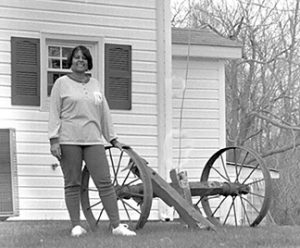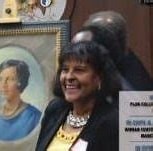Joyce Freeland
A recounting of what life was like for Joyce Freeland growing up in Calvert County during segregation.

Growing up on a Calvert County farm, Joyce Freeland’s dream as a child was to become a farmer. Her father was a farmer and a carpenter to support his family. She grew up around hogs, chickens, horses and cows, and of course tobacco. She eventually concluded that farming was a hard way to make a living. By the time she went to college at Morgan State University, she wanted to become a business education teacher. However, she could not pass the required typing test. So, she switched to business administration, which she found difficult but it also paved the way for a successful career on Capitol Hill in Washington, D.C.
Imagine suffering from a life-threatening condition at the age of four, only to go to the hospital and be treated in a laundry room because there were no beds available for people of your race. This is what Joyce Freeland experienced in the early 1950s while being treated for a ruptured appendix at Calvert Memorial Hospital. “Everything in this county was segregated, even the hospitals,” Freeland said while reminiscing about her upbringing. She still remembers vividly the pain she felt when her appendix ruptured, and the doctor told her parents she had a 50 percent chance of survival. “Just as there was no room in the inn for baby Jesus, there was no available bed for me at Calvert Memorial Hospital in the colored section. And you know they weren’t going to put me in the white section,” she said, adding that the doctor urged hospital staff to find space. “I ended up in the laundry room.”
The Freeland family has strong family ties to Calvert County dating to 1871 when her great grandfather bought the Freeland land. Since then, the Freeland’s family has been a staple in Calvert County. She grew up poor on a family farm in Huntingtown and noted that in the 1950s and 1960s Calvert was one of the poorest counties in Maryland.
Freeland recalled being wary of dogs while walking a mile to get to her school bus stop. Blacks and whites did not ride the same buses, which prompted some black parents to get their own buses for school transportation. There were two high schools in the county — Calvert High School for Whites and William Sampson Brooks High School for Blacks. Although she lived 10 minutes from Brooks High School, Freeland said the bus commute would take up to 45 minutes, as the bus picked her up in Huntingtown and continued to Owings, Sunderland and Chesapeake Beach to get other students.
The integration of schools was a slow process in Calvert County. Freeland explained that schools were supposed to integrate in 1954 after the Brown v. Board of Education ruling, but Calvert was one of many communities that dragged its feet. Only a handful of African-American students were sent to Calvert High for the first couple of years, until William Sampson Brooks High School was closed as a high school in 1966.
“What they were doing was waiting until they could build another school, The Calverton School,” a private school where many white families planned to send their children. “That wasn’t built until 1967 and that’s when the schools integrated”.
“Not only were schools segregated; restaurants, hotels, hospitals and other businesses were, also,” Freeland said. “I think as a result of that, black people created an assortment of businesses in Calvert.”
In her 30-year career, Freeland worked in Washington for Maryland Reps. Parran Mitchell and Kweisi Mfume. She was the assistant to California Democrat Maxine Waters. Freeland recounted many experiences of segregation and inequality even at the highest levels of government. At the beginning of her career while interning, Freeland knew seasoned African American employees who were at extremely low pay grades. While working on Capitol Hill she recalled being shocked to hear some United States senators refer to blacks using derogatory terms. She could only remember a few black employees there, and they either were custodians or elevator operators.
After living in Baltimore, Freeland moved back to Calvert County. She became involved with the Calvert Branch of the NAACP in the late 1980s. Her experiences growing up in Calvert helped her in leading the NAACP branch as president for 28 years.

While things have improved since the 1960s, Freeland feels there is still room for improvement and equity within the school system and county government. “I just hope that we can build better relationships with people of different backgrounds and cultures. We just need to have a better understanding of each other,” she concluded.
This biography is drawn from a story in the Calvert Recorder recognizing Black History Month by publishing stories of those remembering segregation in Calvert County.
Additional Resources
Calvert County NAACP website, September 24, 2027. Joyce Freeland: Public Service on Capitol Hill and in Calvert County – Calvert County NAACP (calvertnaacp.org)
“Celebrating Women’s History Month — The Her-oes of Calvert County”, story & photos by Carol Glover. Celebrating Women’s History Month – The Her-oes of Calvert County (bayweekly.com)
Calvert County Times, 9/21/17 By Dick Myers, Editor. Chronicling Calvert’s black history | Spotlight | somdnews.com
Southern Maryland News, Former NAACP president recalls days of segregation | Spotlight | somdnews.com
Former NAACP president recalls days of segregation | Spotlight | somdnews.com